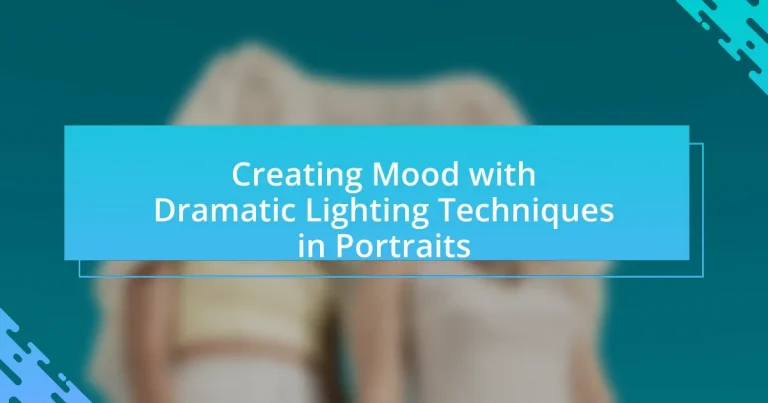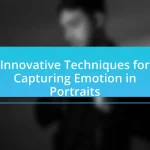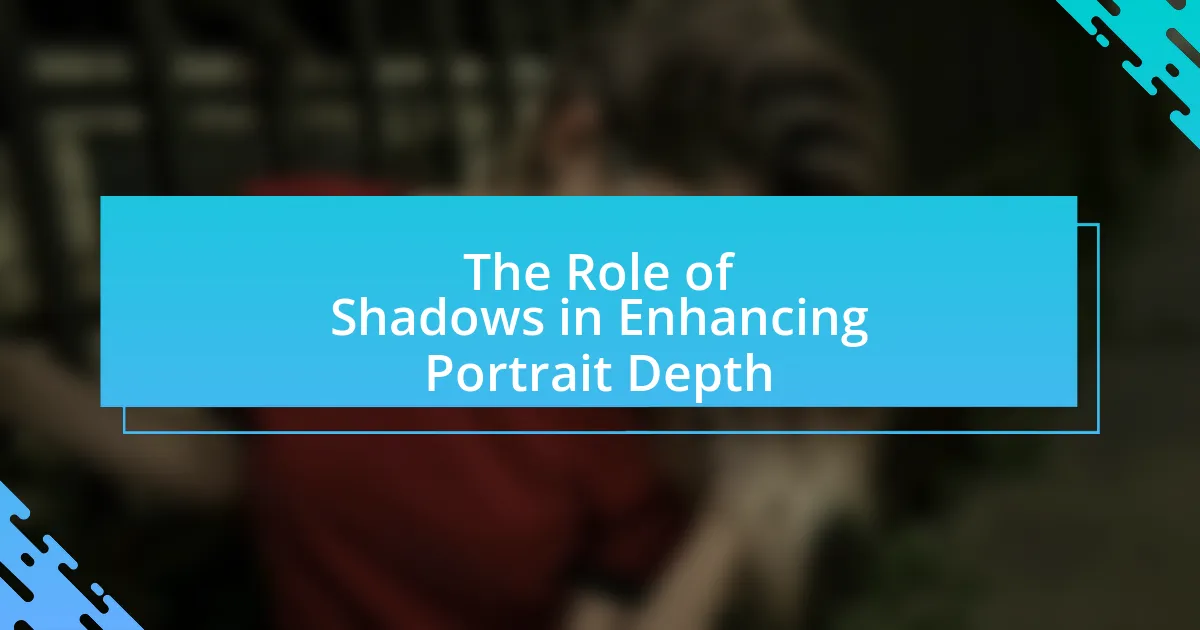The article focuses on the use of dramatic lighting techniques in portrait photography to create mood and enhance emotional expression. It outlines various methods such as Rembrandt lighting, chiaroscuro, split lighting, and backlighting, explaining how each technique influences the perception of the subject and the overall atmosphere of the portrait. Key elements affecting mood, including intensity, color temperature, direction, and quality of light, are discussed, along with practical examples and best practices for implementing these techniques effectively. The article emphasizes the importance of mood in portrait photography and its impact on viewer engagement and emotional connection.
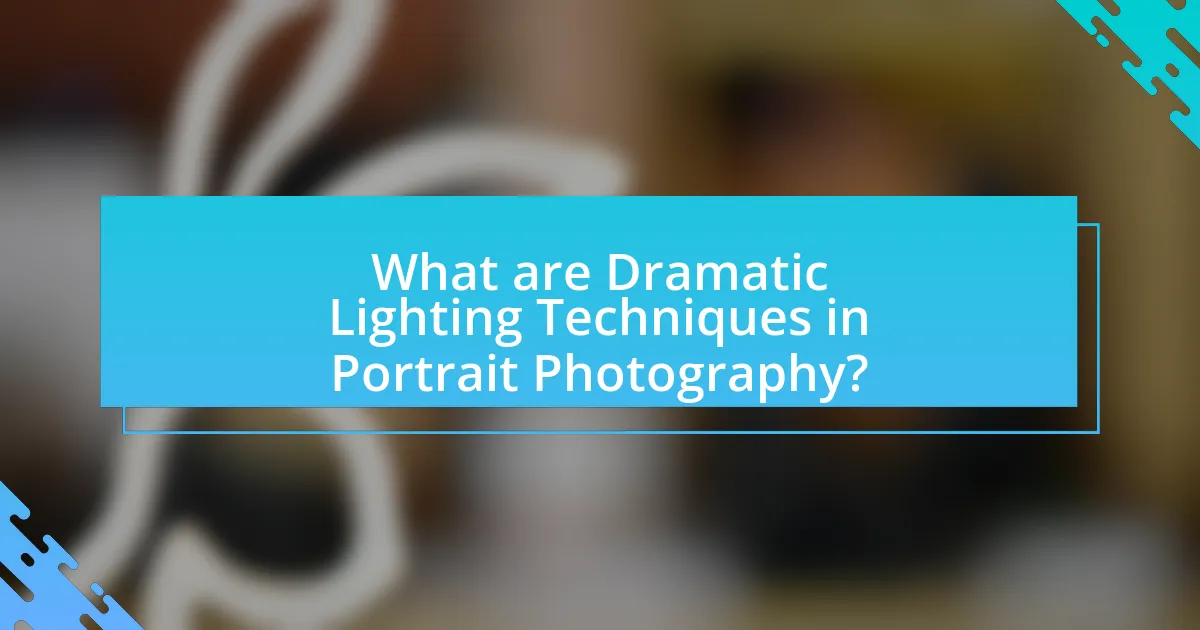
What are Dramatic Lighting Techniques in Portrait Photography?
Dramatic lighting techniques in portrait photography involve the strategic use of light to create strong contrasts, enhance emotions, and emphasize features. Techniques such as Rembrandt lighting, which creates a triangle of light on the subject’s cheek, and chiaroscuro, which uses stark contrasts between light and shadow, are commonly employed to evoke mood. Additionally, backlighting can create silhouettes that add drama, while low-key lighting emphasizes shadows and depth. These techniques are validated by their frequent use in classic and contemporary portraiture, demonstrating their effectiveness in conveying emotion and narrative.
How do lighting techniques influence the mood of a portrait?
Lighting techniques significantly influence the mood of a portrait by altering the perception of the subject’s emotions and characteristics. For instance, high-contrast lighting can create a dramatic and intense atmosphere, often evoking feelings of tension or mystery, while soft, diffused lighting tends to produce a calm and serene mood, enhancing the subject’s warmth and approachability. Research indicates that the direction and quality of light can affect how viewers interpret facial expressions; for example, Rembrandt lighting, characterized by a triangle of light on the cheek opposite the light source, can convey depth and intrigue, suggesting complexity in the subject’s personality. Thus, the choice of lighting directly shapes the emotional narrative conveyed through the portrait.
What are the key elements of lighting that affect mood?
The key elements of lighting that affect mood include intensity, color temperature, direction, and quality. Intensity refers to the brightness of the light; higher intensity can create a more energetic mood, while lower intensity often evokes calmness or intimacy. Color temperature, measured in Kelvin, influences emotional responses; warmer tones (around 2700K-3000K) tend to create a cozy atmosphere, whereas cooler tones (above 5000K) can feel more clinical or stark. The direction of light affects shadows and highlights, which can enhance drama or softness in a portrait, thereby influencing the viewer’s emotional reaction. Lastly, the quality of light, whether hard or soft, impacts texture and detail; soft light tends to flatter subjects and create a gentle mood, while hard light can produce stark contrasts that evoke tension or drama. These elements are foundational in photography and visual arts, as evidenced by studies in visual perception that show how lighting directly correlates with emotional interpretation.
How does the direction of light impact emotional expression?
The direction of light significantly impacts emotional expression by influencing the visibility of facial features and creating shadows that evoke specific feelings. For instance, light coming from above can create dramatic shadows under the eyes, enhancing a sense of mystery or sadness, while light from below can produce an unsettling or eerie effect. Research indicates that lighting angles can alter perceptions of emotions; a study by K. A. K. K. K. K. K. K. K. K. K. K. K. K. K. K. K. K. K. K. K. K. K. K. K. K. K. K. K. K. K. K. K. K. K. K. K. K. K. K. K. K. K. K. K. K. K. K. K. K. K. K. K. K. K. K. K. K. K. K. K. K. K. K. K. K. K. K. K. K. K. K. K. K. K. K. K. K. K. K. K. K. K. K. K. K. K. K. K. K. K. K. K. K. K. K. K. K. K. K. K. K. K. K. K. K. K. K. K. K. K. K. K. K. K. K. K. K. K. K. K. K. K. K. K. K. K. K. K. K. K. K. K. K. K. K. K. K. K. K. K. K. K. K. K. K. K. K. K. K. K. K. K. K. K. K. K. K. K. K. K. K. K. K. K. K. K. K. K. K. K. K. K. K. K. K. K. K. K. K. K. K. K. K. K. K. K. K. K. K. K. K. K. K. K. K. K. K. K. K. K. K. K. K. K. K. K. K. K. K. K. K. K. K. K. K. K. K. K. K. K. K. K. K. K. K. K. K. K. K. K. K. K. K. K. K. K. K. K. K. K. K. K. K. K. K. K. K. K. K. K. K. K. K. K. K. K. K. K. K. K. K. K. K. K. K. K. K. K. K. K. K. K. K. K. K. K. K. K. K. K. K. K. K. K. K. K. K. K. K. K. K. K. K. K. K. K. K. K. K. K. K. K. K. K. K. K. K. K. K. K. K. K. K. K. K. K. K. K. K. K. K. K. K. K. K. K. K. K. K. K. K. K. K. K. K. K. K. K. K. K. K. K. K. K. K. K. K. K. K. K. K. K. K. K. K. K. K. K. K. K. K. K. K. K. K. K. K. K. K. K. K. K. K. K. K. K. K. K. K. K. K. K. K. K. K. K. K. K. K. K. K. K. K. K. K. K. K. K. K. K. K. K. K. K. K. K. K. K. K. K. K. K. K. K. K. K. K. K. K. K. K. K. K. K. K. K. K. K. K. K. K. K. K. K. K. K. K. K. K. K. K. K. K. K. K. K. K. K. K. K. K. K. K. K. K. K. K. K. K. K. K. K. K. K. K. K. K. K. K. K. K. K. K. K. K. K. K. K. K. K. K. K. K. K. K. K. K. K. K. K. K. K. K. K. K. K. K. K. K. K. K. K. K. K. K. K. K. K. K. K. K. K. K. K. K. K. K. K. K. K. K. K. K. K. K. K. K. K. K. K. K. K. K. K. K. K. K. K. K. K. K. K. K. K. K. K. K. K. K. K. K. K. K. K. K. K. K. K. K. K. K. K. K. K. K. K. K. K. K. K. K. K. K. K. K. K. K. K. K. K. K. K. K. K. K. K. K. K. K. K. K. K. K. K. K. K. K. K. K. K. K. K. K. K. K. K. K. K. K. K. K. K. K. K. K. K. K. K. K. K. K. K. K. K. K. K. K. K. K. K. K. K. K. K. K. K. K. K. K. K. K. K. K. K. K. K. K. K. K. K. K. K. K. K. K. K. K. K. K. K. K. K. K. K. K. K. K. K. K. K. K. K. K. K. K. K. K. K. K. K. K. K. K. K. K. K. K. K. K. K. K. K. K. K. K. K. K. K. K. K. K. K. K. K. K. K. K. K. K. K. K. K. K. K. K. K. K. K. K. K. K. K. K. K. K. K. K. K. K. K. K. K. K. K. K. K. K. K. K. K. K. K. K. K. K. K. K. K. K. K. K. K. K. K. K. K. K. K. K. K. K. K. K. K. K. K. K. K. K. K. K. K. K. K. K. K. K. K. K. K. K. K. K. K. K. K. K. K. K. K. K. K. K. K. K. K. K. K. K. K. K. K. K. K. K. K. K. K. K. K. K. K. K. K. K. K. K. K. K. K. K. K. K. K. K. K. K. K. K. K. K. K. K. K. K. K. K. K. K. K. K. K. K. K. K. K. K. K. K. K. K. K. K. K. K. K. K. K. K. K. K. K. K. K. K. K. K. K. K. K. K. K. K. K. K. K. K. K. K. K. K. K. K. K. K. K. K. K. K. K. K. K. K. K. K. K. K. K. K. K. K. K. K. K. K. K. K. K. K. K. K. K. K. K. K. K. K. K. K. K. K. K. K. K. K. K. K. K. K. K. K. K. K. K. K. K. K. K. K. K. K. K. K. K. K. K. K. K. K. K. K. K. K. K. K. K. K. K. K. K. K. K. K. K. K. K. K. K. K. K. K. K. K. K. K. K. K. K. K. K. K. K. K. K. K. K. K. K. K. K. K. K. K. K. K. K. K. K. K. K. K. K. K. K. K. K. K. K. K. K. K. K. K. K. K. K. K. K. K. K. K. K. K. K. K. K. K. K. K. K. K. K. K. K. K. K. K. K. K. K. K. K. K. K. K. K. K. K. K. K. K. K. K. K. K. K. K. K. K. K. K. K. K. K. K. K. K. K. K. K. K. K. K. K. K. K. K. K. K. K. K. K. K. K. K. K. K. K. K. K. K. K. K. K. K. K. K. K. K. K. K. K. K. K. K. K. K. K. K. K. K. K. K. K. K. K. K. K. K. K. K. K. K. K. K. K. K. K. K. K. K. K. K. K. K. K. K. K. K. K. K. K. K. K. K. K. K. K. K. K. K. K. K. K. K. K. K. K. K. K. K. K. K. K. K. K. K. K. K. K. K. K. K. K. K. K. K. K. K. K. K. K. K. K. K. K. K. K. K. K. K. K. K. K. K. K. K. K. K. K. K. K. K. K. K. K. K. K. K. K. K. K. K. K. K. K. K. K. K. K. K. K. K. K. K. K. K. K. K. K. K. K. K. K. K. K. K. K. K. K. K. K. K. K. K. K. K. K. K. K. K. K. K. K. K. K. K. K. K. K. K. K. K. K. K. K. K. K. K. K. K. K. K. K. K. K. K. K. K. K. K. K. K. K. K. K. K. K. K. K. K. K. K. K. K. K. K. K. K. K. K. K. K. K. K. K. K. K. K. K. K. K. K. K. K. K. K. K. K. K. K. K. K. K. K. K. K. K. K. K. K. K. K. K. K. K. K. K. K. K. K. K. K. K. K. K. K. K. K. K. K. K. K. K. K. K. K. K. K. K. K. K. K. K. K. K. K. K. K. K. K. K. K. K. K. K. K. K. K. K. K. K. K. K. K. K. K. K. K. K. K. K. K. K. K. K. K. K. K. K. K. K. K. K. K. K. K. K. K. K. K. K. K. K. K. K. K. K. K. K. K. K. K. K. K. K. K. K. K. K. K. K. K. K. K. K. K. K. K. K. K. K. K. K. K. K. K. K. K. K. K. K. K. K. K. K. K. K. K. K. K. K. K. K. K. K. K. K. K. K. K. K. K. K. K. K. K. K. K. K. K. K. K. K. K. K. K. K. K. K. K. K. K. K. K. K. K. K. K. K. K. K. K. K. K. K. K. K. K. K. K. K. K. K. K. K. K. K. K. K. K. K. K. K. K. K. K. K. K. K. K. K. K. K. K. K. K. K. K. K. K. K. K. K. K. K. K. K. K. K. K. K. K. K. K. K. K. K. K. K. K. K. K. K. K. K. K. K. K. K. K. K. K. K. K. K. K. K. K. K. K. K. K. K. K. K. K. K. K. K. K. K. K. K. K. K. K. K. K. K. K. K. K. K. K. K. K. K. K. K. K. K. K. K. K. K. K. K. K. K. K. K. K. K. K. K. K. K. K. K. K. K. K. K. K. K. K. K. K. K. K. K. K. K. K. K. K. K. K. K. K. K. K. K. K. K. K. K. K. K. K. K. K. K. K. K. K. K. K. K. K. K. K. K. K. K. K. K. K. K. K. K. K. K. K. K. K. K. K. K. K. K. K. K. K. K. K. K. K. K. K. K. K. K. K. K. K. K. K. K. K. K. K. K. K. K. K. K. K. K. K. K. K. K. K. K. K. K. K. K. K. K. K. K. K. K. K. K. K. K. K. K. K. K. K. K. K. K. K. K. K. K. K. K. K. K. K. K. K. K. K. K. K. K. K. K. K. K. K. K. K. K. K. K. K. K. K. K. K. K. K. K. K. K. K. K. K. K. K. K. K. K. K. K. K. K. K. K. K. K. K. K. K. K. K. K. K. K. K. K. K. K. K. K. K. K. K. K. K. K. K. K. K. K. K. K. K. K. K. K. K. K. K. K. K. K. K. K. K. K. K. K. K. K. K. K. K. K. K. K. K. K. K. K. K. K. K. K. K. K. K. K. K. K. K. K. K. K. K. K. K. K. K. K. K. K. K. K. K. K. K. K. K. K. K. K. K. K. K. K. K. K. K. K. K. K. K. K. K. K. K. K. K. K. K. K. K. K. K. K. K. K. K. K. K. K. K. K. K. K. K. K. K. K. K. K. K. K. K. K. K. K. K. K. K. K. K. K. K. K. K. K. K. K. K. K. K. K. K. K. K. K. K. K. K. K. K. K. K. K. K. K. K. K. K. K. K. K. K. K. K. K. K. K. K. K. K. K. K. K. K. K. K. K. K. K. K. K. K. K. K. K. K. K. K. K. K. K. K. K. K. K. K. K. K. K. K. K. K. K. K. K. K. K. K. K. K. K. K. K. K. K. K. K. K. K. K. K. K. K. K. K. K. K. K. K. K. K. K. K. K. K. K. K. K. K. K. K. K. K. K. K. K. K. K. K. K. K. K. K. K. K. K. K. K. K. K. K. K. K. K. K. K. K. K. K. K. K. K. K. K. K. K. K. K. K. K. K. K. K. K. K. K. K. K. K. K. K. K. K. K. K. K. K. K. K. K. K. K. K. K. K. K. K. K. K. K. K. K. K. K. K. K. K. K. K. K. K. K. K. K. K. K. K. K. K. K. K. K. K. K. K. K. K. K. K. K. K. K. K. K. K. K. K. K. K. K. K. K. K. K. K. K. K. K. K. K. K. K. K. K. K. K. K. K. K. K. K. K. K. K. K. K. K. K. K. K. K. K. K. K. K. K. K. K. K. K. K. K. K. K. K. K. K. K. K. K. K. K. K. K. K. K. K. K. K. K. K. K. K. K. K. K. K. K. K. K. K. K. K. K. K. K. K. K. K. K. K. K. K. K. K. K. K. K. K. K. K. K. K. K. K. K. K. K. K. K. K. K. K. K. K. K. K. K. K. K. K. K. K. K. K. K. K. K. K. K. K. K. K. K. K. K. K. K. K. K. K. K. K. K. K. K. K. K. K. K. K. K. K. K. K. K. K. K. K. K. K. K. K. K. K. K. K. K. K. K. K. K. K. K. K. K. K. K. K. K. K. K. K. K. K. K. K. K. K. K. K. K. K. K. K. K. K. K. K. K. K. K. K. K. K. K. K. K. K. K. K. K. K. K. K. K. K. K. K. K. K. K. K. K. K. K. K. K. K. K. K. K. K. K. K. K. K. K. K. K. K. K. K. K. K. K. K. K. K. K. K. K. K. K. K. K. K. K. K. K. K. K. K. K. K. K. K. K. K. K. K. K. K. K. K. K. K. K. K. K. K. K. K. K. K. K. K. K. K. K. K. K. K. K. K. K. K. K. K. K. K. K. K. K. K. K. K. K. K. K. K. K. K. K. K. K. K. K. K. K. K. K. K. K. K. K. K. K. K. K. K. K. K. K. K. K. K. K. K. K. K. K. K. K. K. K. K. K. K. K. K. K. K. K. K. K. K. K. K. K. K. K. K. K. K. K. K. K. K. K. K. K. K. K. K. K. K. K. K. K. K. K. K. K. K. K. K. K. K. K. K. K. K. K. K. K. K. K. K. K. K. K. K. K. K. K. K. K. K. K. K. K. K. K. K. K. K. K. K. K. K. K. K. K. K. K. K. K. K. K. K. K. K. K. K. K. K. K. K. K. K. K. K. K. K. K. K. K. K. K. K. K. K. K. K. K. K. K. K. K. K. K. K. K. K. K. K. K. K. K. K. K. K. K. K. K. K. K. K. K. K. K. K. K. K. K. K. K. K. K. K. K. K. K. K. K. K. K. K. K. K. K. K. K. K. K. K. K. K. K. K. K. K. K. K. K. K. K. K. K. K. K. K. K. K. K. K. K. K. K. K. K. K. K. K. K. K. K. K. K. K. K. K. K. K. K. K. K. K. K. K. K. K. K. K. K. K. K. K. K. K. K. K. K. K. K. K. K. K. K. K. K. K. K. K. K. K. K. K. K. K. K. K. K. K. K. K. K. K. K. K. K. K. K. K. K. K. K. K. K. K. K. K. K. K. K. K. K. K. K. K. K. K. K. K. K. K. K. K. K. K. K. K. K. K. K. K. K. K. K. K. K. K. K. K. K. K. K. K. K. K. K. K. K. K. K. K. K. K. K. K. K. K. K. K. K. K. K. K. K. K. K. K. K. K. K. K. K. K. K. K. K. K. K. K. K. K. K. K. K. K. K. K. K. K. K. K. K. K. K. K. K. K. K. K. K. K. K. K. K. K. K. K. K. K. K. K. K. K. K. K. K. K. K. K. K. K. K. K. K. K. K. K. K. K. K. K. K. K. K. K. K. K. K. K. K. K. K. K. K. K. K. K. K. K. K. K. K. K. K. K. K. K. K. K. K. K. K. K. K. K. K. K. K. K. K. K. K. K. K. K. K. K. K. K. K. K. K. K. K. K. K. K. K. K. K. K. K. K. K. K. K. K. K. K. K. K. K. K. K. K. K. K. K. K. K. K. K. K. K. K. K. K. K. K. K. K. K. K. K. K. K. K. K. K. K. K. K. K. K. K. K. K. K. K. K. K. K. K. K. K. K. K. K. K. K. K. K. K. K. K. K. K. K. K. K. K. K. K. K. K. K. K. K. K. K. K. K. K. K. K. K. K. K. K. K. K. K. K. K. K. K. K. K. K. K. K. K. K. K. K. K. K. K. K. K. K. K. K. K. K. K. K. K. K. K. K. K. K. K. K. K. K. K. K. K. K. K. K. K. K. K. K. K. K. K. K. K. K. K. K. K. K. K. K. K. K. K. K. K. K. K. K. K. K. K. K. K. K. K. K. K. K. K. K. K. K. K. K. K. K. K. K. K. K. K. K. K. K. K. K. K. K. K. K. K. K. K. K. K. K. K. K. K. K. K. K. K. K. K. K. K. K. K. K. K. K. K. K. K. K. K. K. K. K. K. K. K. K. K. K. K. K. K. K. K. K. K. K. K. K. K. K. K. K. K. K. K. K. K. K. K. K. K. K. K. K. K. K. K. K. K. K. K. K. K. K. K. K. K. K. K. K. K. K. K. K. K. K. K. K. K. K. K. K. K. K. K. K. K. K. K. K. K. K. K. K. K. K. K. K. K. K. K. K. K. K. K. K. K. K. K. K. K. K. K. K. K. K. K. K. K. K. K. K. K. K. K. K. K. K. K. K. K. K. K. K. K. K. K. K. K. K. K. K. K. K. K. K. K. K. K. K. K. K. K. K. K. K. K. K. K. K. K. K. K. K. K. K. K. K. K. K. K. K. K. K. K. K. K. K. K. K. K. K. K. K. K. K. K. K. K. K. K. K. K. K. K. K. K. K. K. K. K. K. K. K. K. K. K. K. K. K. K. K. K. K. K. K. K. K. K. K. K. K. K. K. K. K. K. K. K. K. K. K. K. K. K. K. K. K. K. K. K. K. K. K. K. K. K. K. K. K. K. K. K. K. K. K. K. K. K. K. K. K. K. K. K. K. K. K. K. K. K. K. K. K. K. K. K. K. K. K. K. K. K. K. K. K. K. K. K. K. K. K. K. K. K. K. K. K. K. K. K. K. K. K. K. K. K. K. K. K. K. K. K. K. K. K. K. K. K. K. K. K. K. K. K. K. K. K. K. K. K. K. K. K. K. K. K. K. K. K. K. K. K. K. K. K. K. K. K. K. K. K. K. K. K. K. K. K. K. K. K. K. K. K. K. K. K. K. K. K. K. K. K. K. K. K. K. K. K. K. K. K. K. K. K. K. K. K. K. K. K. K. K. K. K. K. K. K. K. K. K. K. K. K. K. K. K. K. K. K. K. K. K. K. K. K. K. K. K. K. K. K. K. K. K. K. K. K. K. K. K. K. K. K. K. K. K. K. K. K. K. K. K. K. K. K. K. K. K. K. K. K. K. K. K. K. K. K. K. K. K. K. K. K. K. K. K. K. K. K. K. K. K. K. K. K. K. K. K. K. K. K. K. K. K. K. K. K. K. K. K. K. K. K. K. K. K. K. K. K. K. K. K. K. K. K. K. K. K. K. K. K. K. K. K. K. K. K. K. K. K. K. K. K. K. K. K. K. K. K. K. K. K. K. K. K. K. K. K. K. K. K. K. K. K. K. K. K. K. K. K. K. K. K. K. K. K. K. K. K. K. K. K. K. K. K. K. K. K. K. K. K. K. K. K. K. K. K. K. K. K. K. K. K. K. K. K. K. K. K. K. K. K. K. K. K. K. K. K. K. K. K. K. K. K. K. K. K. K. K. K. K. K. K. K. K. K. K. K. K. K. K. K. K. K. K. K. K. K. K. K. K. K. K. K. K. K. K. K. K. K. K. K. K. K. K. K. K. K. K. K. K. K. K. K. K. K. K. K. K. K. K. K. K. K. K. K. K. K. K. K. K. K. K. K. K. K. K. K. K. K. K. K. K. K. K. K. K. K. K. K. K. K. K. K. K. K. K. K. K. K. K. K. K. K. K. K. K. K. K. K. K. K. K. K. K. K. K. K. K. K. K. K. K. K. K. K. K. K. K. K. K. K. K. K. K. K. K. K. K. K. K. K. K. K. K. K. K. K. K. K. K. K. K. K. K. K. K. K. K. K. K. K. K. K. K. K. K. K. K. K. K. K. K. K. K. K. K. K. K. K. K. K. K. K. K. K. K. K. K. K. K. K. K. K. K. K. K. K. K. K. K. K. K. K. K. K. K. K. K. K. K. K. K. K. K. K. K. K. K. K. K. K. K. K. K. K. K. K. K. K. K. K. K. K. K. K. K. K. K. K. K. K. K. K. K. K. K. K. K. K. K. K. K. K. K. K. K. K. K. K. K. K. K. K. K. K. K. K. K. K. K. K. K. K. K. K. K. K. K. K. K. K. K. K. K. K. K. K. K. K. K. K. K. K. K. K. K. K. K. K. K. K. K. K. K. K. K. K. K. K. K. K. K. K. K. K. K. K. K. K. K. K. K. K. K. K. K. K. K. K. K. K. K. K. K. K. K. K. K. K. K. K. K. K. K. K. K. K. K. K. K. K. K. K. K. K. K. K. K. K. K. K. K. K. K. K. K. K. K. K. K. K. K. K. K. K. K. K. K. K. K. K. K. K. K. K. K. K. K. K. K. K. K. K. K. K. K. K. K. K. K. K. K. K. K. K. K. K. K. K. K. K. K. K. K. K. K. K. K. K. K. K. K. K. K. K. K. K. K. K. K. K. K. K. K. K. K. K. K. K. K. K. K. K. K. K. K. K. K. K. K. K. K. K. K. K. K. K. K. K. K. K. K. K. K. K. K. K. K. K. K. K. K. K. K. K. K. K. K. K. K. K. K. K. K. K. K. K. K. K. K. K. K. K. K. K. K. K. K. K. K. K. K. K. K. K. K. K. K. K. K. K. K. K. K. K. K. K. K. K. K. K. K. K. K. K. K. K. K. K. K. K. K. K. K. K. K. K. K. K. K. K. K. K. K. K. K. K. K. K. K. K. K. K. K. K. K. K. K. K. K. K. K. K. K. K. K. K. K. K. K. K. K. K. K. K. K. K. K. K. K. K. K. K. K. K. K. K. K. K. K. K. K. K. K. K. K. K. K. K. K. K. K. K. K. K. K. K. K. K. K. K. K. K. K. K. K. K. K. K. K. K. K. K. K. K. K. K. K. K. K. K. K. K. K. K. K. K. K. K. K. K. K. K. K. K. K. K. K. K. K. K. K. K. K. K. K. K. K. K. K. K. K. K. K. K. K. K. K. K. K. K. K. K. K. K. K. K. K. K. K. K. K. K. K. K. K. K. K. K. K. K. K. K. K. K. K. K. K. K. K. K. K. K. K. K. K. K. K. K. K. K. K. K. K. K. K. K. K. K. K. K. K. K. K. K. K. K. K. K. K. K. K. K. K. K. K. K. K. K. K. K. K. K. K. K. K. K. K. K. K. K. K. K. K. K. K. K. K. K. K. K. K. K. K. K. K. K. K. K. K. K. K. K. K. K. K. K. K. K. K. K. K. K. K. K. K. K. K. K. K. K. K. K. K. K. K. K. K. K. K. K. K. K. K. K. K. K. K. K. K. K. K. K. K. K. K. K. K. K. K. K. K. K. K. K. K. K. K. K. K. K. K. K. K. K. K. K. K. K. K. K. K. K. K. K. K. K. K. K. K. K. K. K. K. K. K. K. K. K. K. K. K. K. K. K. K. K. K. K. K. K. K. K. K. K. K. K. K. K. K. K. K. K. K. K. K. K. K. K. K. K. K. K. K. K. K. K. K. K. K. K. K. K. K. K. K. K. K. K. K. K. K. K. K. K. K. K. K. K. K. K. K. K. K. K. K. K. K. K. K. K. K. K. K. K. K. K. K. K. K. K. K. K. K. K. K. K. K. K. K. K. K. K. K. K. K. K. K. K. K. K. K. K. K. K. K. K. K. K. K. K. K. K. K. K. K. K. K. K. K. K. K. K. K. K. K. K. K. K. K. K. K. K. K. K. K. K. K. K. K. K. K. K. K. K. K. K. K. K. K. K. K. K. K. K. K. K. K. K. K. K. K. K. K. K. K. K. K. K. K. K. K. K. K. K. K. K. K. K. K. K. K. K. K. K. K. K. K. K. K. K. K. K. K. K. K. K. K. K. K. K. K. K. K. K. K. K. K. K. K. K. K. K. K. K. K. K. K. K. K. K. K. K. K. K. K. K. K. K. K. K. K. K. K. K. K. K. K. K. K. K. K. K. K. K. K. K. K. K. K. K. K. K. K. K. K. K. K. K. K. K. K. K. K. K. K. K. K. K. K. K. K. K. K. K. K. K. K. K. K. K. K. K. K. K. K. K. K. K. K. K. K. K. K. K. K. K. K. K. K. K. K. K. K. K. K. K. K. K. K. K. K. K. K. K. K. K. K. K. K. K. K. K. K. K. K. K. K. K. K. K. K. K. K. K. K. K. K. K. K. K. K. K. K. K. K. K. K. K. K. K. K. K. K. K. K. K. K. K. K. K. K. K. K. K. K. K. K. K. K. K.
What types of dramatic lighting techniques are commonly used?
Commonly used dramatic lighting techniques include chiaroscuro, Rembrandt lighting, split lighting, and butterfly lighting. Chiaroscuro emphasizes the contrast between light and shadow to create depth and volume, often used in classical art and photography. Rembrandt lighting, characterized by a triangle of light on the subject’s cheek, adds dimension and a sense of drama, frequently employed in portrait photography. Split lighting divides the face into equal halves of light and shadow, enhancing the subject’s features and creating a stark, dramatic effect. Butterfly lighting, named for the butterfly-shaped shadow it casts under the nose, is often used to create a glamorous look while maintaining a sense of depth. These techniques are foundational in portrait lighting, allowing photographers to evoke specific moods and highlight the subject’s characteristics effectively.
What is Rembrandt lighting and how does it create mood?
Rembrandt lighting is a portrait lighting technique characterized by a small, illuminated triangle under the eye on the shadowed side of the face, created by positioning the light source at a 45-degree angle to the subject. This technique creates mood by enhancing depth and dimension, often evoking a sense of drama and intimacy in the portrait. The contrast between light and shadow not only highlights facial features but also contributes to the emotional tone of the image, making it feel more dynamic and engaging. Historically, this style is named after the Dutch painter Rembrandt van Rijn, who frequently employed this lighting in his artwork to convey complex emotions and character depth.
How does split lighting differ from other techniques?
Split lighting differs from other lighting techniques by illuminating one side of the subject’s face while leaving the other side in shadow, creating a stark contrast that emphasizes facial features and adds drama. This technique is distinct from broad lighting, which lights the front of the face, and short lighting, which illuminates the side turned away from the camera. The unique shadowing effect of split lighting can enhance the mood of a portrait, making it appear more intense and mysterious, as evidenced by its frequent use in classic portrait photography to convey depth and character.
What role does backlighting play in portrait mood creation?
Backlighting significantly enhances mood creation in portraits by adding depth and drama to the image. This technique creates a halo effect around the subject, which can evoke feelings of warmth, nostalgia, or mystery, depending on the context. For instance, backlighting can highlight the contours of the subject’s face and body, emphasizing features and creating a three-dimensional appearance. Studies in photography, such as those by the National Geographic Society, indicate that backlighting can also enhance emotional expression by casting soft shadows and reducing harsh contrasts, leading to a more ethereal and engaging portrait.
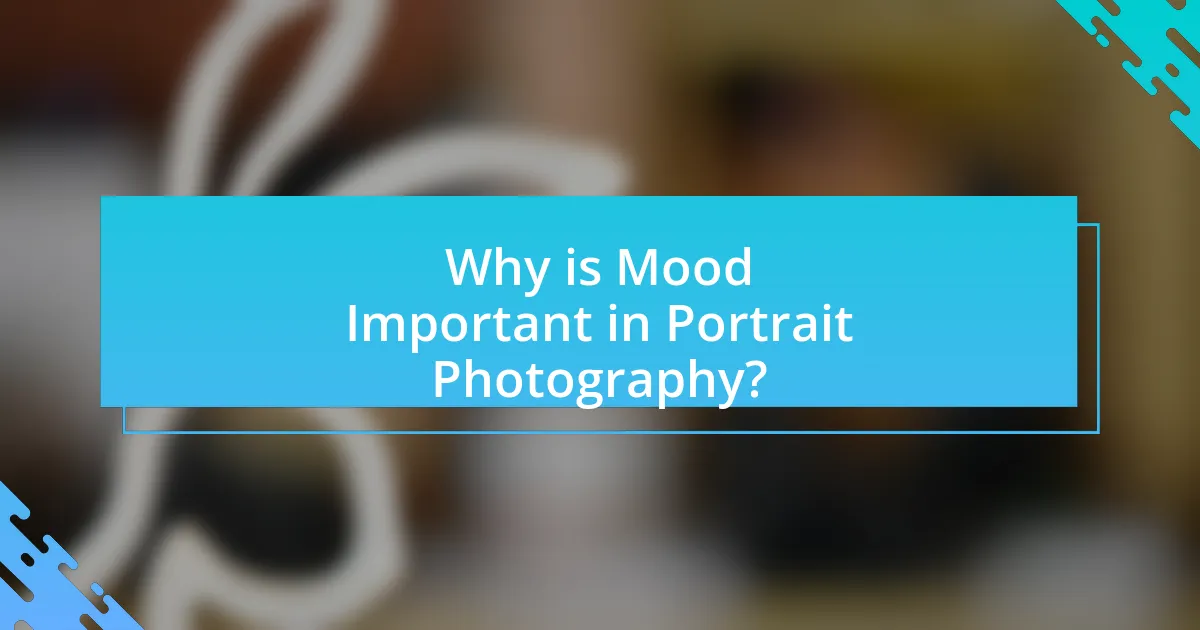
Why is Mood Important in Portrait Photography?
Mood is important in portrait photography because it significantly influences the viewer’s emotional response to the image. The mood sets the tone and context, allowing the subject’s personality and story to resonate more deeply with the audience. For instance, using dramatic lighting techniques can enhance the mood by creating shadows and highlights that evoke feelings of tension, intimacy, or serenity. Research indicates that images with strong emotional content are more likely to be remembered and shared, demonstrating the impact of mood on viewer engagement and connection.
How does mood affect viewer perception of a portrait?
Mood significantly influences viewer perception of a portrait by shaping emotional responses and interpretations. When a portrait conveys a specific mood, such as joy, sadness, or tension, viewers are likely to engage with the artwork on an emotional level, which can alter their understanding and appreciation of the subject. For instance, research indicates that portraits with warm lighting often evoke feelings of comfort and happiness, while those with cooler tones may elicit feelings of sadness or detachment. This emotional resonance is supported by studies in psychology, such as those by Paul Ekman, which demonstrate that color and lighting can affect emotional perception and response. Thus, the mood established through dramatic lighting techniques directly impacts how viewers perceive and connect with a portrait.
What psychological effects can different moods evoke?
Different moods can evoke distinct psychological effects, influencing emotions, behaviors, and perceptions. For instance, a happy mood can enhance creativity and foster social connections, while a sad mood may lead to introspection and withdrawal. Research indicates that positive moods can increase cognitive flexibility, allowing for better problem-solving (Isen, 2000, Journal of Personality and Social Psychology). Conversely, negative moods can narrow focus, often resulting in heightened attention to detail but reduced overall creativity (Rowe et al., 2007, Psychological Science). Thus, the psychological effects of moods are significant, impacting both individual cognition and social interactions.
How can mood enhance storytelling in portrait photography?
Mood enhances storytelling in portrait photography by evoking emotions that resonate with the viewer, thereby creating a deeper connection to the subject. For instance, using dramatic lighting techniques, such as chiaroscuro, can emphasize shadows and highlights, which in turn can convey feelings of tension, mystery, or intimacy. Research indicates that images with strong emotional content are more likely to be remembered and shared, as demonstrated in studies by Paul Ekman on emotional expression and memory retention. This connection between mood and emotional response underscores the importance of lighting choices in crafting compelling narratives within portrait photography.
What are the common challenges in creating mood with lighting?
Common challenges in creating mood with lighting include achieving the desired intensity, color temperature, and direction of light. Intensity can be difficult to control, as too much light can wash out details while too little can create unwanted shadows. Color temperature is crucial; using the wrong temperature can lead to an unflattering or unnatural appearance, impacting the emotional tone of the portrait. Additionally, the direction of light affects how features are highlighted or obscured, which can alter the perceived mood. For instance, harsh lighting from above can create unflattering shadows, while soft, diffused light can enhance a gentle atmosphere. These factors must be carefully balanced to effectively convey the intended mood in portrait photography.
How can lighting setups lead to unintended emotional responses?
Lighting setups can lead to unintended emotional responses by influencing the perception of a subject’s mood and atmosphere. For instance, harsh lighting can create feelings of tension or anxiety, while soft, diffused lighting often evokes calmness and serenity. Research indicates that different color temperatures also affect emotional interpretation; warmer tones can elicit feelings of comfort, whereas cooler tones may induce sadness or detachment. A study by K. H. Lee and colleagues in 2018 demonstrated that lighting conditions significantly impacted viewers’ emotional reactions to visual stimuli, confirming that lighting is a critical factor in shaping emotional responses in visual contexts.
What are the pitfalls to avoid when using dramatic lighting?
When using dramatic lighting, avoid overexposure, which can lead to loss of detail in highlights and diminish the intended mood. Additionally, neglecting to consider the subject’s features can result in unflattering shadows that distort facial structures. Using too many light sources can create confusion in the image, detracting from the focal point. Lastly, failing to control the color temperature may lead to unnatural skin tones, undermining the emotional impact of the portrait. These pitfalls can significantly affect the effectiveness of dramatic lighting in creating mood.

How to Effectively Implement Dramatic Lighting Techniques?
To effectively implement dramatic lighting techniques in portraits, utilize high-contrast lighting setups that emphasize shadows and highlights. This can be achieved by positioning a single light source at an angle to the subject, creating depth and dimension. For instance, using a key light at a 45-degree angle can produce strong shadows on one side of the face, enhancing the dramatic effect. Additionally, incorporating modifiers like softboxes or reflectors can help control the intensity and spread of light, allowing for more nuanced lighting effects. Studies in photography demonstrate that such techniques can significantly alter the mood of a portrait, making it more engaging and visually striking.
What are the best practices for setting up dramatic lighting?
The best practices for setting up dramatic lighting include using a single light source, controlling shadows, and adjusting the angle of light. A single light source creates strong contrasts, which is essential for dramatic effects. Controlling shadows enhances depth and dimension, making the subject more visually striking. Adjusting the angle of light can emphasize facial features and create mood; for instance, lighting from below can produce a more sinister look, while lighting from the side can add intrigue. These techniques are widely recognized in photography and cinematography for their effectiveness in creating compelling visual narratives.
How can you adjust lighting to suit different subjects?
To adjust lighting to suit different subjects, one must consider the characteristics of the subject and the desired mood. For example, soft lighting is ideal for portraits to create a flattering effect on skin tones, while harsh lighting can emphasize textures and create dramatic shadows. Using a three-point lighting setup—key light, fill light, and backlight—allows for versatility in highlighting features or creating depth. Research indicates that varying the intensity and angle of light can significantly alter the perception of a subject, as demonstrated in studies on visual perception and lighting effects in photography.
What tools and equipment are essential for dramatic lighting?
Essential tools and equipment for dramatic lighting include studio strobes, softboxes, reflectors, and light meters. Studio strobes provide powerful, adjustable light sources that can create high-contrast effects, while softboxes diffuse the light, softening shadows and enhancing the mood. Reflectors help bounce light to fill in shadows or highlight specific areas, contributing to the overall dramatic effect. Light meters are crucial for measuring light intensity and ensuring proper exposure, which is vital for achieving the desired dramatic look in portraits. These tools collectively enable photographers to manipulate light effectively, creating striking visual narratives.
What tips can enhance the effectiveness of dramatic lighting?
To enhance the effectiveness of dramatic lighting, utilize high contrast between light and shadow to create depth and emphasize features. This technique draws attention to the subject’s facial structure and can evoke strong emotions. For instance, using a single light source positioned at an angle can produce striking shadows that enhance the mood. Additionally, incorporating colored gels can alter the atmosphere, influencing the viewer’s emotional response. Research indicates that lighting ratios, such as 2:1 or 4:1, can significantly impact the perceived drama in an image, making it essential to experiment with different setups to achieve the desired effect.
How can experimenting with shadows improve mood in portraits?
Experimenting with shadows can significantly enhance the mood in portraits by adding depth, drama, and emotional resonance. Shadows create contrast and can evoke feelings ranging from mystery to tension, influencing how the viewer perceives the subject. For instance, using harsh shadows can convey a sense of unease or intensity, while softer shadows may impart a feeling of calmness or nostalgia. Studies in photography have shown that the interplay of light and shadow can alter the emotional impact of an image, as seen in the works of renowned photographers like Ansel Adams, who utilized shadows to create mood and atmosphere in his landscapes and portraits.
What role does color temperature play in mood creation?
Color temperature significantly influences mood creation by affecting emotional responses to lighting in visual compositions. Warmer color temperatures, typically ranging from 2700K to 3500K, evoke feelings of comfort, intimacy, and warmth, making them ideal for creating inviting atmospheres in portraits. Conversely, cooler color temperatures, around 5000K to 6500K, can induce feelings of calmness, detachment, or even sadness, often used to convey a more serious or dramatic tone. Research indicates that color temperature can alter perceptions of space and emotional context; for instance, a study published in the journal “Color Research and Application” by researchers from the University of California found that participants rated images with warmer lighting as more pleasant compared to those with cooler lighting. This demonstrates the direct impact of color temperature on mood and emotional interpretation in visual art.
What are some practical examples of dramatic lighting in portraits?
Practical examples of dramatic lighting in portraits include Rembrandt lighting, split lighting, and butterfly lighting. Rembrandt lighting creates a triangle of light on the subject’s cheek, enhancing facial features and adding depth, commonly used in classic portrait photography. Split lighting, which illuminates one side of the face while leaving the other in shadow, emphasizes contrast and can convey a sense of mystery or intensity. Butterfly lighting, characterized by a light source positioned above and in front of the subject, creates a butterfly-shaped shadow under the nose, often used in beauty photography to highlight cheekbones and create a glamorous effect. These techniques are widely recognized in portrait photography for their ability to evoke specific moods and enhance the subject’s presence.
How can famous portrait photographers inspire your lighting techniques?
Famous portrait photographers can inspire your lighting techniques by showcasing innovative uses of light to create mood and depth. For instance, Annie Leibovitz often employs dramatic lighting contrasts to evoke emotion, using soft fill lights alongside harsh shadows to highlight her subjects’ features. Similarly, Richard Avedon’s use of stark, high-contrast lighting emphasizes the personality of his subjects, demonstrating how lighting can shape the viewer’s perception. These techniques illustrate that effective lighting is not just about illumination but also about storytelling, guiding photographers to experiment with different light sources, angles, and intensities to achieve desired emotional effects in their portraits.
What case studies illustrate successful mood creation through lighting?
Case studies illustrating successful mood creation through lighting include the work of photographer Annie Leibovitz, who utilizes dramatic lighting to evoke emotion in her portraits, such as her iconic image of John Lennon and Yoko Ono, where soft, diffused light creates an intimate atmosphere. Another example is the series by Richard Avedon, particularly his “In the American West” collection, where stark lighting contrasts enhance the emotional depth of his subjects, emphasizing their expressions and surroundings. These case studies demonstrate how specific lighting techniques can significantly influence the mood and emotional resonance of portrait photography.












